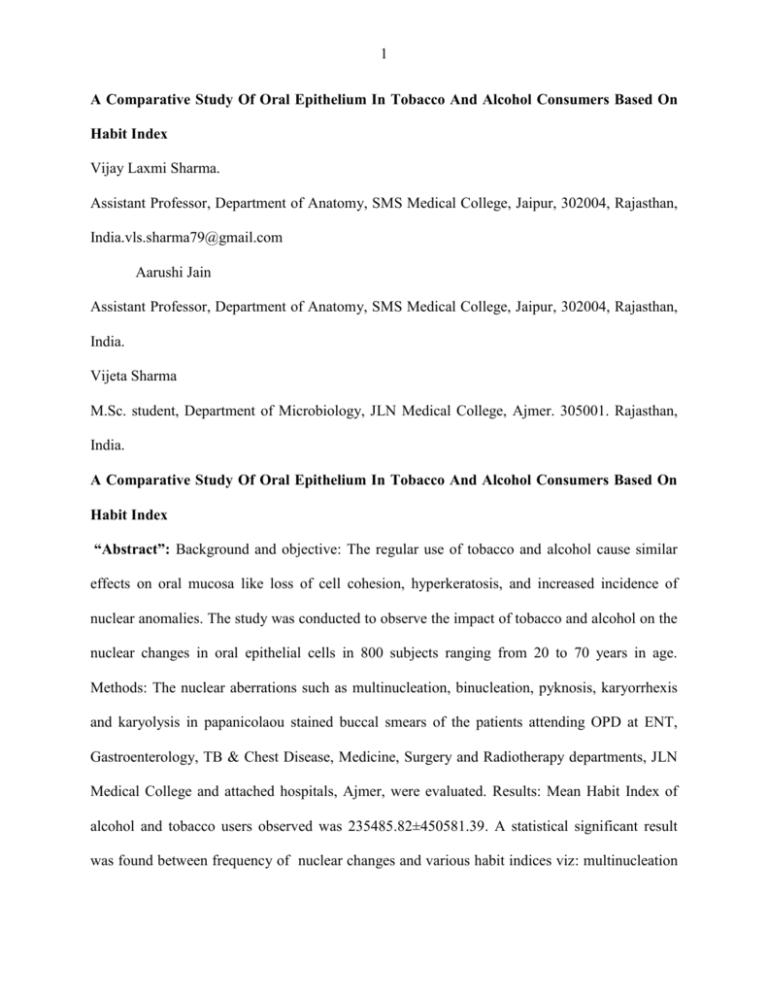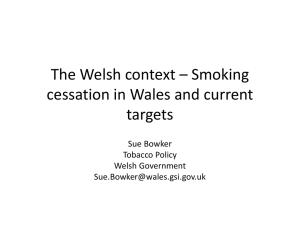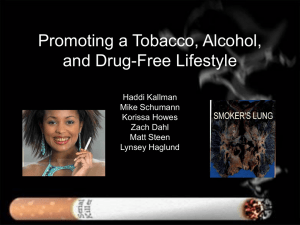A Comparative Study Of Oral Epithelium In Tobacco And Alcohol
advertisement

1 A Comparative Study Of Oral Epithelium In Tobacco And Alcohol Consumers Based On Habit Index Vijay Laxmi Sharma. Assistant Professor, Department of Anatomy, SMS Medical College, Jaipur, 302004, Rajasthan, India.vls.sharma79@gmail.com Aarushi Jain Assistant Professor, Department of Anatomy, SMS Medical College, Jaipur, 302004, Rajasthan, India. Vijeta Sharma M.Sc. student, Department of Microbiology, JLN Medical College, Ajmer. 305001. Rajasthan, India. A Comparative Study Of Oral Epithelium In Tobacco And Alcohol Consumers Based On Habit Index “Abstract”: Background and objective: The regular use of tobacco and alcohol cause similar effects on oral mucosa like loss of cell cohesion, hyperkeratosis, and increased incidence of nuclear anomalies. The study was conducted to observe the impact of tobacco and alcohol on the nuclear changes in oral epithelial cells in 800 subjects ranging from 20 to 70 years in age. Methods: The nuclear aberrations such as multinucleation, binucleation, pyknosis, karyorrhexis and karyolysis in papanicolaou stained buccal smears of the patients attending OPD at ENT, Gastroenterology, TB & Chest Disease, Medicine, Surgery and Radiotherapy departments, JLN Medical College and attached hospitals, Ajmer, were evaluated. Results: Mean Habit Index of alcohol and tobacco users observed was 235485.82±450581.39. A statistical significant result was found between frequency of nuclear changes and various habit indices viz: multinucleation 2 with chewing index, alcoholic + smoking index, smoking+tobacco chewing index; binucleation with alcoholic +tobacco chewing index; karyorrhexis with alcoholic +tobacco chewing index, smoking+tobacco chewing index; karyolysis with chewing index, smoking+tobacco chewing index; pyknosis with smoking index, alcoholic + smoking index, smoking+tobacco chewing index, alcoholic + smoking + tobacco chewing index. Conclusion: Microscopically examined nuclear changes are a useful tool in early diagnosis of the oral carcinoma. “Key words”: Buccal smear; Habit index; Micronuclei; Oral epithelium; Oral cytology; Papanicolaou “Introduction”: Alcohol and Tobacco are the most common drugs of abuse, and consumed as one of the chief sources of variety of pleasure of life. Since there is a close association between presence of chromosomal aberrations and carcinogenic exposure on the buccal mucosa, examination of nuclear changes has been used since 1937 as an indicator of genotoxic exposures (1). After the evolution of pap smear and pap stains, a number of studies have been carried out which evaluate papanicolaou stain for studying nuclear changes in buccal cells under field conditions and concluded that pap stain are the preferred method in field studies for scoring and detecting the nuclear anomalies in cells of buccal mucosa (2,3). Oral cytology is becoming increasingly important in the early diagnosis of oral cancers, as a procedure for obtaining cell samples that can then be analysed by sophisticated diagnostic techniques (4). A lot of research work has been carried out to observe the nuclear changes associated with the use of tobacco and alcohol (5-10). 3 In order to evaluate cellular changes induced by tobacco and alcohol consumption, exfoliative cytology is used for the analysis of mucosal smears obtained from the buccal mucosa. The purpose of this study involves examination of epithelial smears to determine the prevalence of cells containing nuclear anomalies. “Materials and methods”: The present study was carried out on individuals selected from the patients attending the ENT, Gastroenterology, TB & Chest, Medicine, Surgery and Radiotherapy outdoors during the period from February 2008 to February 2011. The sample size was calculated using decision analyst software at 95% confidence level alpha error 5%. The subjects were classified in 8 habit groups viz, alcoholics (A), smokers(S), tobacco chewers(TC), alcoholics and smokers(A+S), alcoholics and chewers(A+C), smokers and chewers(S+C), alcoholics and smokers and chewers(A+S+C) and control (C, persons were not habituated to any form of tobacco consumption or alcohol intake). After seeking ethical acceptance from the review board committee of the institution, a proper consent and the history of the patient were recorded. The patients were then subjected to sample collection. The subject was asked to rinse the mouth with drinking water. Taking all the aseptic precautions, a wooden spatula was then used to scrape the sample area (inner side of the cheek) three to four times with firm pressure. The slides were coded before scraping the mucosa so as to avoid confusion and the sample was spread on the slide. These slides were stained according to Papanicolaou staining technique. The smears were then observed under 40X and 100X magnifications. From each subject, a minimum of 1000 cells were screened for calculating the frequency of nuclear anomalies which includes multinucleation, binucleation, pyknosis, karyorrhexis and karyolysis. Analysis- 4 Calculation of various habit indices: Use during the previous year or last year of usage was applied to estimate lifetime exposure, which was computed with the following formula (11). Exposure to chewing tobacco was calculated as: (Chewing Index) Total Chaws in grams/Day X 365 days/Year X Years =Total Chaws of chewing tobacco use. [A chaw was defined as the typical portion size of chewing tobacco (Quantity of chewing tobacco used in grams per day) used by the subject.] Cigarette consumption was determined by the following: (Smoking Index) Total Cigarettes/day X 365 days/Year X Years = Total Cigarettes in lifetime Alcohol concentration was computed as follows: (Alcohol Index) Total Episode/Day X 365 Days/year X Years = Total Episode Life exposure The data thus generated were analyzed using chi square test, the significance level was considered at p< 0.05. Study design: cross sectional study. “Results”: In the present study most of the subjects were in the age group of 40-49 years (26.22%), followed by 50-59 years (20.50%), 30-39 years (19.75%), 60-70 years (19.12%), and 14% within the age group of 20-29 years. Out of 800 subjects the total number of males was 761 (95.12%), and females were 39 (4.88%) (Table1). 5 Mean Habit Index of alcohol and tobacco consumption observed was 235485.82±450581.39. It ranged from 501397.20± 592069.90 (Alcoholic group) to 13742.54±18610.38 (Tobacco Chewer group). (Table 2) Table 3 depicts the distribution of subjects according to various habit indices and frequency of nuclear changes and shows the results as follows – The presence of multinucleation was significant (p<0.05), when it was compared with the Chewing, Alcohol+Smoking and Smoking+Chewing habit indices. In these habit indices, frequency of multinucleation ranged from: (1) 38.37%-71.43% (Chewing Index); (2) 15.79%-37.50% (Alcohol+Smoking index); (3) 47.44%-72.73% (Smoking+Chewing Index); The occurrence of binucleation among different ranges of Alcoholic+Tobacco Chewing Index, varied in between 13.04% - 29.03%, and this finding was on significant level.(p<0.05). The range of occurrence of pyknosis in the following habit indices was on significant level (p<0.05): (1) 15.19% -47.62% (Smoking Index); (2) 17.1% - 45.83% (Alcohol+Smoking Index); (3) 48.72% - 86.36% (Smoking+Chewing Index); (4) 37.7% - 64.41% (Alcohol+Smoking+Chewing Index); The relation between presence of pyknosis and Alcohol+Chewing Index was found to be on highly significant level (p<0.001). The frequency varied from 36.23% to 77.4%. 6 On categorization of subjects according to their degree of use i.e. habit index and frequency of karyorrhexis, significant results were obtained with respect to Alcohol+Chewing Index (p<0.01) and Smoking+Chewing Index (p<0.05) The range of frequency of Karyorrhexis in the above mentioned habit indices varied from: (1) 27.54% - 51.61% (Alcohol+ Chewing Index); (2) 33.33% - 59.09% (Smoking+Chewing Index); The relation between occurrence of Karyolysis with respect to Alcohol Index and Alcohol+Smoking+Chewing Index was found to be statistically highly significant (p<0.001). In these habit indices the variation of frequency was as follows: (1) 36.90% - 87.50% (Alcohol Index); (2) 52.46% - 89.74% (Alcohol+Smoking+Chewing Index); This study showed significant result when we compared ocurrence of karyolysis with Smoking Index, Alcohol+Smoking Index, Alcohol+Chewing Index (p<0.01) and the variation in the frequency of karyolysis was observed as follows: (1) 43.04% - 76.09% (Smoking Index); (2) 52.63% - 79.17% (Alcohol+Smoking Index); (3) 52.17% - 80.64% (Alcohol+Chewing Index); “Discussion”: Nuclear aberrations are either acentric chromosome fragments or whole chromosome lagging in the normal karyokinesis (12, 13). These laggards or fragments of chromosomes are excluded from the post mitotic daughter cells and form nuclei. The induction of nuclear anomalies in oral mucosal cells seems to be due to the presence of genotoxic agents in the tobacco and alcohol. According to Livingston et al (14), saliva soluble compounds present in tobacco could diffuse into the basal cell layer and disturb the reproductive 7 mechanism of the underlying proliferating cell population, thereby bringing about genotoxicity and formation of nuclear aberrations. Nagler and Dayan (15) have also reported that the interactions between redox active metals in saliva and the low reactive free radicles during chewing and smoking of tobacco enhance the potency of genotoxicity. Alcohol, acting both independently as well as synergistically with smoking has been implicated in oral carcinogenesis (16). More importantly, alcohol may act as a solvent and enhance the penetration of carcinogens into target tissues. Alcohol is metabolized by an enzyme alcohol dehydrogenase and to some extent, by cytochrome p 450 to acetaldehyde which is found to be carcinogenic (17, 18). The growing evidences associate increased alcohol consumption with risk of developing oral carcinoma (19, 20). Earlier reports suggest that the microscopic examination of buccal smears provides evidence of exposure to carcinogens and measure of degree to carcinogen in the tissue from which cancer develops. Increased frequency of nuclear aberrations in buccal mucosal cells of tobacco and alcohol users indicates a high risk group of oral cancer (21-24). “Conclusion”: The increased range of nuclear aberrations and statistical analysis suggest that oral mucosa is susceptible to cancer in those who are consuming alcohol and tobacco in combination as compared to single habit groups. The methodology used in the study is simple, rapid and painless. Such a method is cost effective and can be done in the rural hospitals for the early detection and diagnosis of the oral carcinoma. This will greatly help in early preventive measure. The study indicates that amount of use of tobacco and alcohol, calculated as habit index has a significant effect on the oral mucosa. The limitation of this study was the sample size which could have been larger. This technique is primitive and further research by using 8 relationship between years of use of tobacco and alcohol and frequency of nuclear aberrations is recommended. “Acknowledgements”: Authors are thankful to the Department of Anatomy of JLN Medical College and SMS Medical College for permitting us to conduct the study. “References”: (1). Geard CR, Chen CY: Micronuclei and clonogenecity following low – and high – dose –rate γ-irradiation of normal human fibroblasts (1990), Radiat Res; 124: 856- 861. (2). Sangeeta Palaskara and Chavi Jindal: Evaluation of micronuclei using Papanicolaou and May Grunwald Giemsa stain in individuals with different tobacco habits – A comparative study (2010 December), Journal of Clinical and Diagnostic Research; 4: 3607-3613. (3). S Grover, ABR Mujib, A Jahagirdar, N Telagi, and PG Kulkarni: A comparative study for selectivity of micronuclei in oral exfoliated epithelial cells (2012 Oct-Dec), J Cytol; 29(4): 230– 235. (4). Blozis GG: The value of exfoliative cytology in the diagnosis of oral cancer (1972 Dec), Int Dent J; 22(4):481-6. (5). Sarto F, Finotto S, Giacomelli L, Mazzotti D, Tomanin R, Levis AG: The micronucleus assay in exfoliated cells of the human buccal mucosa (1987), Mutagenesis; 2:11-7. (6). Stich HF, Stich W: Chromosome damaging activity of saliva of betel nut and tobacco chewers (1982), Cancer Lett; 15:193-202. (7). Bohrer PL, Filho MS, Paiva RL, da Silva IL, Rados PV: Assessment of micronucleus frequency in normal oral mucosa of patients exposed to carcinogens (2005), Acta Cytol; 49:26572. 9 (8). Proia NK, Paszkiewicz GM, Nasca MA, Franke GE, Pauly JL: Smoking and smokeless tobacco-associated human buccal cell mutations and their association with oral cancer - a review (2006), Cancer Epidemiol Biomarkers Prev;15:1061-77. (9). Tolbert PE, Cari MS, Allen JW: Micronuclei and other nuclear anomalies in the buccal smears: method development (2003), J mutation; 271(1): 69-77. (10). P. Thomas, N. Holland, C. Bolognesi, M. Kirsch-Volders, S. Bonassi, E. Zeiger, S. Knasmueller, M. Fenech: Buccal micronucleus cytome assay (2009), Nat. Protoc; 4: 825–837. (11) George E. Kaugars, William T. Riley, Richard B. Brandt, James C. Burns D.D.S, John A. Svirsky D.D.S: The prevalence of oral lesions in smokeless tobacco users and an evaluation of risk factors (1 December 1992), Cancer Volume, pages 2579–2585. (12). Schmid, W: The micronucleus test for cytogenetic analysis. In Hollander A (Ed) Chemical (1976), Mutagens; Vol-4 (Plenum Publishing Co., New York): 31-53. (13). Schmid, W: Micronucleus Test: an in vivo bone marrow method (1982), In Hsu TC (Ed) Cytogenetic Assays for Environmental Mutagens, Oxford and IBH Publishing Co., New Delhi, 221-229. (14). Livingston, G.K, Reed, R.N, Olson, B.L and Lockey, J.E: Induction of nuclear aberrations by smokeless tobacco in epithelial cells of human oral mucosa (1990), Environ. Mol. Mutagen; 15: 136-144. (15). Nagler, R. and Dayan, D., The dual role of saliva in oral carcinogenesis (2006), Oncology; 71(1-2): 10-17. (16). Anonymous, Alcohol Drinking. IARC Monograph on the evaluation of carcinogenic rises of chemicals to human (1989), Agency for Research on Cancer (IARC), Lyon, France: 416. (17). Blot, W.J: Alcohol and Cancer (1992), Cancer Research; 52: 2119-2123. 10 (18). Harty, L.C, Capsaraso, N.E, Hayes, R.B, Winn, D.M, Bravo-Otero, E and Blot, W.J: Alcohol dehydrogenase 3 genotype and risk of oral cavity and pharyngeal cancer (1997), J. Natl. Cancer Inst; 89:1698-1705. (19). Petti, S and Scully, C: Oral cancer: The association between nation-based alcohol-drinking profiles and oral cancer mortality (2005), Oral Oncol; 41(8): 828-834. (20). Warnakulasuriya, S, Parkkila, S, Nagao, T, Preedy, U.R, Koivisto, H and Niemela, O: Demonstration of ethanol-induced protein adducts in oral leukoplakia (pre-cancer) and cancer (2008), J. Oral Pathol. Med; 37 (3):157-165. (21). Stich, H.F, Stich, W and Parida, B.B: Elevated frequency of micronucleated cells in the buccal mucosa of individuals at high risk for oral cancer: Betel quid chewers (1982), Cancer Lett; 17: 125-134. (22). Ghosh, U.R and Parida, B.B: Cytological study of exfoliated buccal mucosal cells of tribes in Orissa state (India) with high risk for oral cancer (1995), Ind. J. Cancer; 32(3): 95-99. (23). Heddle, J.A, Hite, M, Kirkhart, B, Mavourrnin, K, MacGregor, J.T, Newell, G.W and Salamone, M.F: The induction of micronuclei as a measure of genotoxicity. A report of the U.S. Environmental Protection Agency Gene-Tox Program (1983), Mutat Res; 123: 61-118. (24). Heddle, J.A and Salamone, M.F: The Micronucleus Assay (1981), In Stich HF and San RHC (Ed) Short term thesis for chemical carcinogens, (Springer-Verlag, New York), 234. 11 TABLE 1. DISTRIBUTION OF SUBJECTS ACCORDING TO AGE & SEX Age group Sex (In Years) Male Female 20-29 104 8 112 (13.00) (1.00) (14.00) 149 9 158 (18.62) (1.12) (19.75) 203 10 213 (25.37) (1.25) (26.62) 158 6 164 (19.75) (0.75) (20.50) 147 6 153 (18.38) (0.75) (19.12) 761 39 800 (95.12) (4.88) (100.00) Total 30-39 40-49 50-59 60-70 Total *figure in paranthesis showing percentage. 12 TABLE 2. MEAN + SD OF INDEX OF HABIT OF VARIOUS GROUP SUBJECTS Group Number of subjects Mean + SD Alcoholic 100 501397.20 + 592069.90 Smoker 100 66882.60 + 104215.40 Tobacco chewer 100 13742.54 + 18610.38 Alcoholic 100 333796.50 + 414673.90 100 264371.40 + 350213.20 100 137263.20 + 527677.80 100 330947.30 + 553865.90 + Smoker Alcoholic + Tobacco chewer Smoker + Tobacco chewer Alcoholic + Smoker + Tobacco chewer 13 TABLE 3. DISTRIBUTION OF SUBJECTS ACCORDING TO HABIT INDEX AND FREQUENCY OF NUCLEAR CHANGES Habit index Multinucleation Binucleation Pyknosis Karyorrhexis Karyolysis A index <200000 >200000 Chi square P value 19.05% 25.00% 0.042 > 0.05 7.14% 12.50% 0.049 > 0.05 23.81% 37.50% 1.309 > 0.05 10.71% 12.50% 0.051 > 0.05 36.90% 87.50% 11.932 < 0.001 S index <200000 >200000 Chi square P value 22.78% 42.86% 3.391 > 0.05 6.33% 9.52% 0.0008 > 0.05 15.19% 47.62% 10.167 < 0.005 11.39% 9.52% 0.022 > 0.05 43.04% 43.04% 7.293 < 0.01 C index <30000 >30000 Chi square P value 38.37% 71.43% 4.103 < .05 13.95% 28.57% 0.981 > 0.05 58.14% 78.57% 1.341 > .05 20.93% 35.71% 1.486 > 0.05 60.46% 71.43% 0.237 > 0.05 (A+S) index <500000 >500000 Chi square P value 15.79% 37.50% 5.182 < .05 6.58% 4.17% 0.003 > .05 17.10% 45.83% 8.253 < .005 9.21% 37.50% 0.022 > .05 52.63% 79.17% 5.309 < .05 (A+C) index < 300000 > 300000 Chi square P value 27.54% 22.58% 0.273 > .05 13.04% 29.03% 3.705 <.05 36.23% 77.42% 14.520 < .001 27.54% 51.61% 5.450 < .02 52.17% 80.64% 7.296 < .01 (S+C) index < 200000 > 200000 Chi square P value 47.44% 72.73% 4.406 <.05 14.10% 31.82% 3.649 > .05 48.72% 86.36% 8.283 < .005 33.33% 59.09% 4.785 < .05 57.69% 77.27% 2.792 > .05 (A+S+C) index < 200000 > 200000 Chi square P value 21.31% 30.77% 1.135 > .05 9.84% 7.69% 0.00005 > .05 37.70% 64.41% 5.450 < .02 29.51% 53.85% 5.923 > .05 52.46% 89.74% 13.320 < .001








